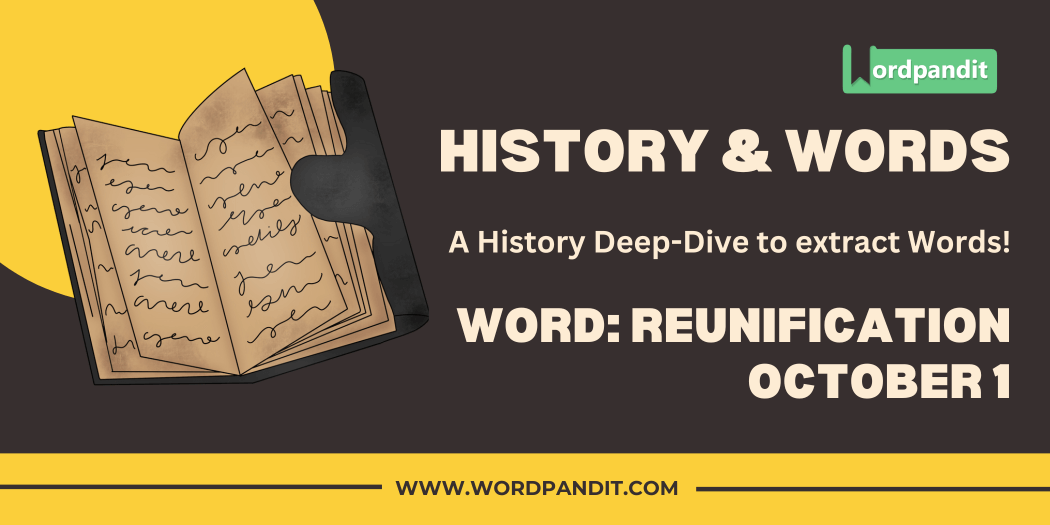History & Words: 'Reunification' (October 1)
Welcome to 'History & Words.' 🌟 I'm Prashant, founder of Wordpandit and the Learning Inc. Network. This series combines my passion for language learning with historical context. Each entry explores a word's significance on a specific date, enhancing vocabulary while deepening understanding of history. Join me in this journey of words through time.
📚 Table of Contents
- Word of the Day
- Introduction
- Etymology
- Key Vocabulary
- Historical Context
- Timeline
- The Day's Significance
- Quote
- Modern Usage and Reflection
- Legacy
- Comparative Analysis
- Did You Know?
- Conclusion
- Further Reading
🔍 Word of the Day: Reunification
Pronunciation: /riːˌjuːnɪfɪˈkeɪʃən/ (ree-yoo-nuh-fi-KAY-shuhn)
🌍 Introduction
On October 1, 1990, the world witnessed a momentous event that would reshape the geopolitical landscape of Europe and mark the end of an era. The reunification of East and West Germany, separated for over four decades, became official on this day, symbolizing the fall of the Iron Curtain and the conclusion of the Cold War division in Europe.
The word "reunification" encapsulates the essence of this historic moment, representing the coming together of two entities that were once whole. It's a term that resonates not only with the German people but also with nations and communities worldwide that have experienced division and separation.
The significance of reunification extends far beyond the borders of Germany. It serves as a powerful reminder of the human desire for unity, the complexities of political divisions, and the potential for peaceful resolution of long-standing conflicts. The German reunification stands as a testament to the possibility of overcoming seemingly insurmountable barriers and the triumph of shared cultural identity over ideological differences.
[Insert image of Berlin Wall being torn down]
🌱 Etymology
The word "reunification" is derived from the prefix "re-," meaning "again" or "anew," and "unification," which comes from the Latin "unificare" (to make one). The term literally means "the act of making one again." While the concept of uniting separate entities has existed throughout history, the specific term "reunification" gained prominence in political discourse during the 20th century, particularly in the context of divided nations and territories.
📖 Key Vocabulary
- 🔑 Cold War: The state of geopolitical tension between the Western Bloc (led by the United States) and the Eastern Bloc (led by the Soviet Union) from 1947 to 1991.
- 🔑 Iron Curtain: The ideological and physical boundary dividing Europe into two separate areas from the end of World War II until the end of the Cold War.
- 🔑 Deutsche Demokratische Republik (DDR): The official name of East Germany.
- 🔑 Bundesrepublik Deutschland (BRD): The official name of West Germany.
- 🔑 Ostalgie: A portmanteau of the German words for "east" and "nostalgia," referring to nostalgia for aspects of life in East Germany.
🏛️ Historical Context
The concept of reunification has played a significant role throughout history, often emerging in the aftermath of conflicts, political divisions, or colonial rule. While the German reunification of 1990 is one of the most well-known examples, the idea of reuniting divided lands and peoples has been a recurring theme in global affairs.
In ancient times, the unification of Upper and Lower Egypt under Pharaoh Narmer around 3100 BCE can be considered an early example of reunification. Similarly, the unification of China under the Qin Dynasty in 221 BCE brought together warring states into a single empire.
The modern era has seen numerous instances of reunification efforts, often in response to the aftermath of wars or colonial rule. The Italian Unification (Risorgimento) in the 19th century and the reunification of Vietnam in 1976 after the Vietnam War are notable examples.
The partition and subsequent reunification of nations became a prominent issue in the 20th century, particularly in the context of the Cold War. The division of Korea following World War II, which remains unresolved, and the partition of India in 1947 are examples of divisions that have shaped regional and global politics.
The German case stands out due to its peaceful nature and its symbolic importance in marking the end of the Cold War era in Europe. It serves as a model for peaceful reunification, though the process was not without its challenges and controversies.
⏳ Timeline
- 1945: Germany is divided into four occupation zones after World War II
- 1949: Establishment of two German states: the Federal Republic of Germany (West) and the German Democratic Republic (East)
- August 13, 1961: Construction of the Berlin Wall begins
- 1972: Basic Treaty between East and West Germany improves relations
- 1989: Peaceful revolution in East Germany; fall of the Berlin Wall on November 9
- 1990:
- March 18: First free elections in East Germany
- July 1: Monetary, Economic and Social Union between East and West Germany
- August 31: Signing of the Unification Treaty
- October 3: Official reunification of Germany
🌟 The Day's Significance
October 1, 1990, marks the official reunification of Germany, a date chosen to coincide with the implementation of the Unification Treaty signed on August 31, 1990. This day represented the culmination of a rapid and largely peaceful process that had begun with the fall of the Berlin Wall on November 9, 1989.
The events leading up to this historic day were set in motion by a series of reforms in the Soviet Union under Mikhail Gorbachev, known as perestroika and glasnost. These reforms weakened the Soviet Union's control over its satellite states, including East Germany. Mass protests in East Germany, coupled with a flood of East Germans fleeing to the West through Hungary, created unstoppable momentum towards reunification.
The immediate impact of reunification was profound. Overnight, the German Democratic Republic ceased to exist, and its territory was incorporated into the Federal Republic of Germany. The political, economic, and social systems of West Germany were extended to the east. This process, often referred to as "Wiedervereinigung" in German, was not merely an administrative change but a complex merging of two societies that had developed differently over four decades.
Key figures in the reunification process included West German Chancellor Helmut Kohl, who saw the historic opportunity and pushed for rapid reunification, and East German Prime Minister Lothar de Maizière, who led the first and only democratically elected government of East Germany and negotiated the reunification treaty.
The long-term impacts of reunification have been far-reaching. While it brought freedom and economic opportunities to East Germans, it also led to significant economic challenges, including high unemployment in the east as state-owned industries collapsed. The process of integrating two different societies proved more difficult and costly than initially anticipated, leading to debates about the effectiveness of the reunification process.
Controversies surrounding reunification include discussions about the rapid pace of the process, the economic disparities between east and west that persist to this day, and debates about the cultural losses experienced by East Germans as their society was effectively absorbed into the West German model.
[Insert map of reunified Germany]
💬 Quote
"I have a vision of a completely united Europe, of a Europe without dividing lines, without opposing blocs. That is our goal, and we are striving for it." - Helmut Kohl, Chancellor of Germany (1982-1998)
🔮 Modern Usage and Reflection
Today, "reunification" remains a potent concept in international relations and domestic politics. It's often invoked in discussions about divided nations, such as North and South Korea, or in debates about separatist movements in various countries.
In Germany, the term "innere Einheit" (inner unity) is often used to discuss the ongoing process of social and economic integration between the former East and West. While legal and political reunification was achieved quickly, the process of creating a truly unified society continues to this day.
The German experience of reunification serves as both a model and a cautionary tale for other divided nations. It demonstrates the possibility of peaceful reunification but also highlights the long-term challenges of merging disparate societies and economies.
🏛️ Legacy
The legacy of German reunification extends far beyond Germany's borders. It marked the end of the Cold War division of Europe and contributed to the collapse of communist regimes across Eastern Europe. The event has had lasting effects on European integration, playing a role in the expansion of the European Union and the adoption of the euro.
Within Germany, reunification has led to significant investments in infrastructure and education in the eastern states. While economic disparities persist, there have been notable improvements in living standards and opportunities in the former East Germany.
The reunification process has also sparked ongoing discussions about identity, memory, and the interpretation of history. Museums, memorials, and educational programs continue to explore the complex legacy of division and reunification, ensuring that future generations understand this crucial chapter in German and European history.
🔍 Comparative Analysis
At the time of reunification in 1990, the concept was largely viewed through the lens of triumph over communism and the realization of national unity. There was widespread optimism about the prospects for rapid integration and economic convergence between East and West.
Today, the understanding of reunification is more nuanced. While the achievement of national unity is still celebrated, there's greater recognition of the complexities and challenges involved in merging two societies. The concept is now often discussed in terms of an ongoing process rather than a single event, with continued efforts needed to address economic disparities and social divisions.
💡 Did You Know?
🎓 Conclusion
The reunification of Germany stands as a pivotal moment in 20th-century history, symbolizing the end of the Cold War era and demonstrating the possibility of peaceful resolution to long-standing divisions. While the process has not been without challenges, it remains a powerful example of the human capacity to overcome ideological barriers and work towards unity. As we continue to face global challenges that require cooperation and understanding, the lessons of German reunification remain relevant and instructive.
📚 Further Reading
- 📘 "Germany Unified and Europe Transformed: A Study in Statecraft" by Philip Zelikow and Condoleezza Rice
- 📗 "The Rush to German Unity" by Konrad H. Jarausch
- 📙 "After the Wall: Germany, the Germans and the Burdens of History" by Marc Fisher
[Insert image of Brandenburg Gate today]

